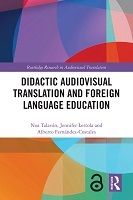Chapter 5 Didactic audio description and didactic free commentary
Proposal review
| dc.contributor.author | TALAVAN, NOA | |
| dc.contributor.author | Lertola, Jennifer | |
| dc.contributor.author | Fernandez-Costales, Alberto | |
| dc.date.accessioned | 2023-12-15T14:10:45Z | |
| dc.date.available | 2023-12-15T14:10:45Z | |
| dc.date.issued | 2024 | |
| dc.identifier.uri | https://library.oapen.org/handle/20.500.12657/86187 | |
| dc.description.abstract | This chapter will focus on didactic Audio Description (AD) and didactic free commentary. Firstly, it will provide the reader with an overview of the main types of didactic AD (DAD) and didactic free-commentary (DFC), differentiating between intersemiotic for both modes as well as intralingual, and interlingual for free commentary. Afterwards, it will present how didactic AD and didactic free commentary can foster communicative skills mainly in terms of audiovisual production and mediation, and audiovisual reception to a certain extent. Guidelines to implement DAD and DFC will be explained in detail together with a sample of assessment rubrics which can be adapted according to the learning contexts. Finally, sample lesson plans on both DAT modes will be presented. | en_US |
| dc.language | English | en_US |
| dc.subject.other | Didactic AVT; AVT; audiovisual translation; didactic audiovisual translation; Foreign language education; Media accessibility; Language and education; Noa Talaván; Jennifer Lertola; Alberto Fernández-Costales | en_US |
| dc.title | Chapter 5 Didactic audio description and didactic free commentary | en_US |
| dc.type | chapter | |
| oapen.identifier.doi | 10.4324/9781003293958-6 | en_US |
| oapen.relation.isPublishedBy | 7b3c7b10-5b1e-40b3-860e-c6dd5197f0bb | en_US |
| oapen.relation.isPartOfBook | c7aa0e0e-9ff1-492a-a41d-9f65e2bc7dec | en_US |
| oapen.relation.isbn | 9781032277585 | en_US |
| oapen.relation.isbn | 9781032277615 | en_US |
| oapen.imprint | Routledge | en_US |
| oapen.pages | 24 | en_US |
| oapen.remark.public | Funder name: TRADILEX project. PID2019-107362GA-I00 AEI/10.13039/501100011033. Spanish Government, Science, and Innovation Ministry | |
| peerreview.anonymity | Single-anonymised | |
| peerreview.id | bc80075c-96cc-4740-a9f3-a234bc2598f1 | |
| peerreview.open.review | No | |
| peerreview.publish.responsibility | Publisher | |
| peerreview.review.stage | Pre-publication | |
| peerreview.review.type | Proposal | |
| peerreview.reviewer.type | Internal editor | |
| peerreview.reviewer.type | External peer reviewer | |
| peerreview.title | Proposal review | |
| oapen.review.comments | Taylor & Francis open access titles are reviewed as a minimum at proposal stage by at least two external peer reviewers and an internal editor (additional reviews may be sought and additional content reviewed as required). |

